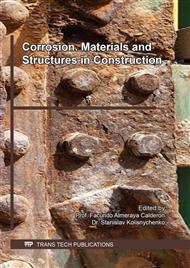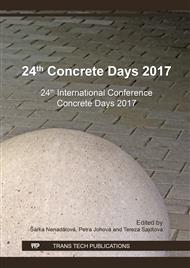p.203
p.209
p.214
p.220
p.226
p.232
p.238
p.244
p.250
Effect of Chloride-Induced Steel Corrosion on Working Life of Concrete Structures
Abstract:
The reinforcing steel embedded in concrete is generally protected against corrosion by the high alkalinity (pH = 12.5 to 13.5) of the concrete pore solution. The structural degradation of concrete structures due to reinforcement’s corrosion has an impact on the safety, serviceability and durability of the structure. The corrosion of reinforcements in the construction of a transport infrastructure (especially bridges), parking areas, etc., is primarily initiated by chlorides from de-icing salts. When corrosion is initiated, active corrosion results in a volumetric expansion of the corrosion products around the reinforcing bars against the surrounding concrete. Reinforcement corrosion causes a volume increase due to the oxidation of metallic iron, which is mainly responsible for exerting the expansive radial pressure at the steel–concrete interface and development of hoop tensile stresses in the surrounding concrete. When this tensile stress exceeds the tensile strength of the concrete, cracks are generated. Higher corrosion rates can lead to the cracking and spalling of the concrete cover. Continued corrosion of reinforcement causes a reduction of total loss of bond between concrete and reinforcement.
Info:
Periodical:
Pages:
226-231
Citation:
Online since:
February 2018
Authors:
Keywords:
Price:
Сopyright:
© 2018 Trans Tech Publications Ltd. All Rights Reserved
Share:
Citation:



